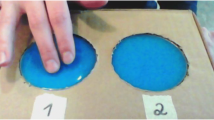Summary
The ability of human subjects to discriminate softness was investigated. In addition, the associated mechanistic cues and the peripheral neural codes on which the discrimination may be based were investigated using monkeys. Two sets of compliant objects were constructed: (1) those with a deformable surface, composed of transparent silicone rubber of variable softness; (2) rigid plates supported by springs of variable compliance in cylindrical sleeves. To assess the relative contributions of tactile and kinesthetic information, psychophysical experiments were performed on human subjects under both active and passive touch, with or without local anesthesia that blocked the tactile information from the fingerpads. The results for objects with deformable surfaces show that whereas the subjects are quite good at discriminating subtle differences in softness under both active and passive touch without anesthesia, they are unable to discriminate even large differences under active touch with anesthesia. Therefore, we conclude that the discrimination is based entirely on tactile information. The mechanistic data for rubber specimens indicates that the basis for the perception of softness of rubber-like objects is likely to be the spatio-temporal variation of pressure on the skin (or, equivalently, the skin displacement and its derivatives). Neurophysiological data shows that the resulting responses from slowly adapting type I afferent population within the skin might encode the compliance of the objects. For compliant objects with rigid surfaces best discrimination was achieved only with active touch, due to the availability of both tactile and kinesthetic information; under passive conditions, the absence of kinesthetic information resulted in considerable deterioration of discriminability
Access this chapter
Tax calculation will be finalised at checkout
Purchases are for personal use only
Preview
Unable to display preview. Download preview PDF.
Similar content being viewed by others
References
Harper, R. (1952) Psychological and psychophysical aspects of studies of craftsmanship in dairying.British Journal of Psychology Monograph Supplement28:1–63.
Harper, R., and Stevens, S. S. (1964) Subjective hardness of compliant materials.Quarterly Journal of Experimental Psychology16:204–215.
Jones, L.A., and Hunter, I.W. (1990) A perceptual analysis of stiffness.Experimental Brain Research79:150–156.
Katz, D. (1938) The judgements of test bakers. A psychological study.Occupational Psychology12:139–148.
LaMotte, R.H., and Srinivasan, M.A. (1993) Responses of cutaneous mechanoreceptors to the shape of objects applied to the primate fingerpad.Acta Psychologica84:41–51.
LaMotte, R.H., Zhang, J. and Yan, J. (1994) Tactile signals generated by a tool used to discriminate the softness of objects.Society for Neuroscience Abstracts20:1381.
Roland, P.E. and Ladegaard-Pedersen, H. (1977) A quantitative analysis of sensations of tension and of kinaesthesia in man.Brain100:671–692.
Srinivasan, M.A., and LaMotte, R.H. (1987) Tactile discrimination of shape: Responses of slowly and rapidly adapting mechanoreceptive afferents to a step indented into the monkey fingerpad.Journal of Neuroscience7:1682–1697.
Srinivasan, M.A., and LaMotte, R.H. (1991) Encoding of shape in the responses of cutaneous mechanoreceptors. In: O. Franzen and J. Westman (Eds.),Information Processing in the Somatosensory System, Wenner-Gren International Symposium Series, Macmillan Press, London, pp 59–69.
Srinivasan, M.A. and LaMotte, R.H. (1995) Tactual discrimination of softness.Journal of Neurophysiology73:88–101.
Tan, H.Z., Durlach, N.I., Beauregard, G.L., and Srinivasan, M.A. (1995) Manual discrimination of compliance using active pinch grasp: The roles of force and work cues.Perception and Psychophysics57:495–510.
Author information
Authors and Affiliations
Editor information
Editors and Affiliations
Rights and permissions
Copyright information
© 1996 Birkhäuser Verlag Basel/Switzerland
About this chapter
Cite this chapter
Srinivasan, M.A., LaMotte, R.H. (1996). Tactual discrimination of softness: abilities and mechanisms. In: Franzén, O., Johansson, R., Terenius, L. (eds) Somesthesis and the Neurobiology of the Somatosensory Cortex. Advances in Life Sciences. Birkhäuser Basel. https://doi.org/10.1007/978-3-0348-9016-8_11
Download citation
DOI: https://doi.org/10.1007/978-3-0348-9016-8_11
Publisher Name: Birkhäuser Basel
Print ISBN: 978-3-0348-9868-3
Online ISBN: 978-3-0348-9016-8
eBook Packages: Springer Book Archive




